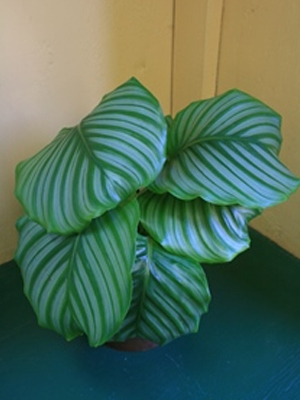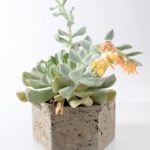Calathea: Colorful Foliar Tapestry for Your Indoor Garden
Calathea is one of the most stunning houseplants available to the indoor gardener. When it comes to looks and decorating your home, the intricately marked foliage on this eye-catching indoor plant rivals any high-end fabric. Use calathea to complement the décor of a room, or simply as an unforgettable focal point.
Originating from Mexico to northern Argentina, calatheas come in a wide variety of foliage patterns and colors. The well-known peacock plant (Calathea zebrina) features dark green and light green alternating striping. Calathea leaves tend to be oval-shaped and vary in size, depending on the variety.

Photo, Julie Bawden-Davis
To have success growing calathea, keep the following cultivation tips in mind.
Give calathea proper lighting
The delicate leaves of calathea are easily sunburned, so grow the plant in a location with medium light, such as several feet away from an eastern window, or in a northern window. They also thrive under full-spectrum lighting.
Expose calathea to mild temperatures
Calathea is originally from the tropics and for that reason does best in mild indoor temperatures, ranging from 65-75 degrees F. Avoid placing them in chilly rooms during the winter months, and don’t put calathea in rooms hotter than 80 degrees F. in the summer months.
Watering calathea
Keep calathea soil continuously moist but not soggy most of the year. When temperatures dip in winter, let the top inch of soil dry out in between waterings. Always water with tepid or warm water, never cold, as the latter will cause leaf spotting and can stunt plant roots.
Mulch with a 1-inch layer of shredded bark to keep the calathea soil moist and the beneficial soil microbes thriving.
Fertilizing calathea
Feed calathea monthly with an all-purpose, organic fertilizer. Regular feeding will keep the plant growing well and the leaves lustrous and colorful.
Provide calathea humidity
As tropical plants, calathea does best in humid conditions. Mist a few times a day, if possible, and place the plant over a humidity tray. Grouping calathea with other houseplants also helps to raise the nearby relative humidity.
Watch for pests
Calatheas fall prey to spider mites and scale. Check for these pests on a regular basis. Treat spider mites with insecticidal soap and prevent by keeping the humidity up. Eradicate scale with neem oil.





